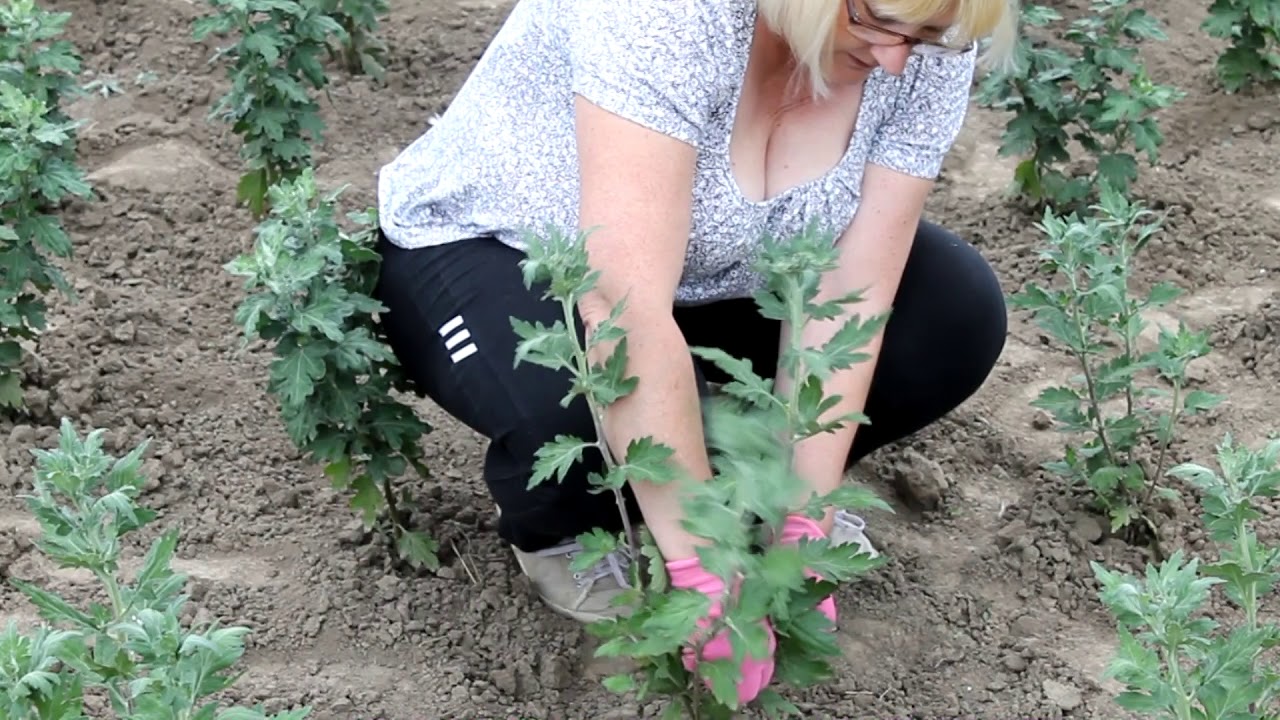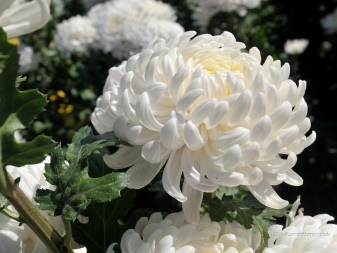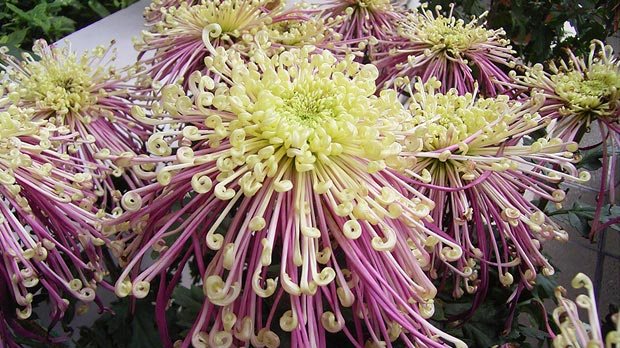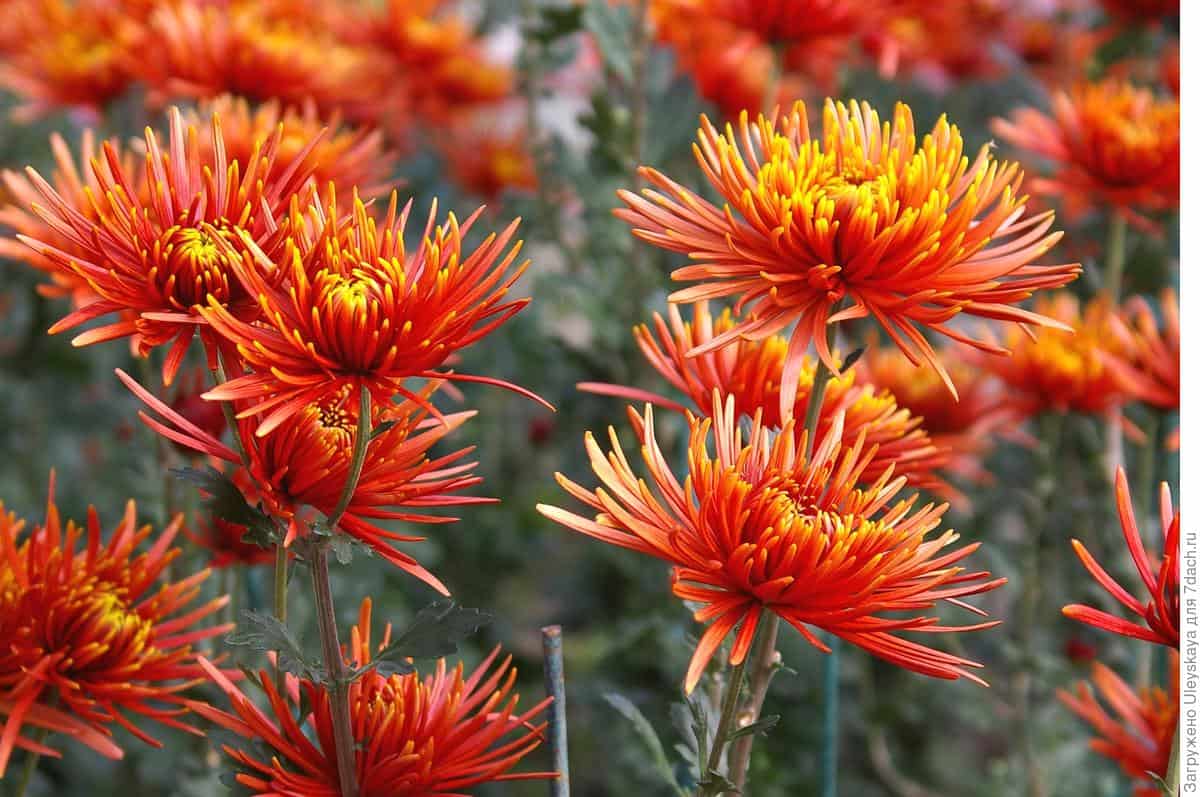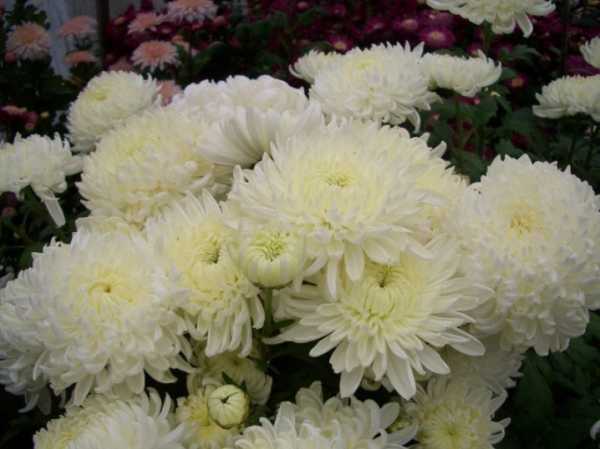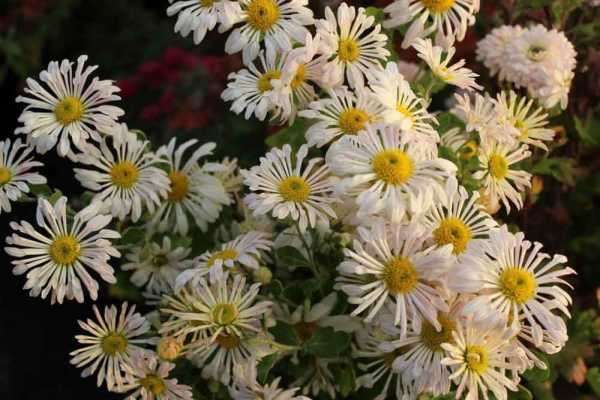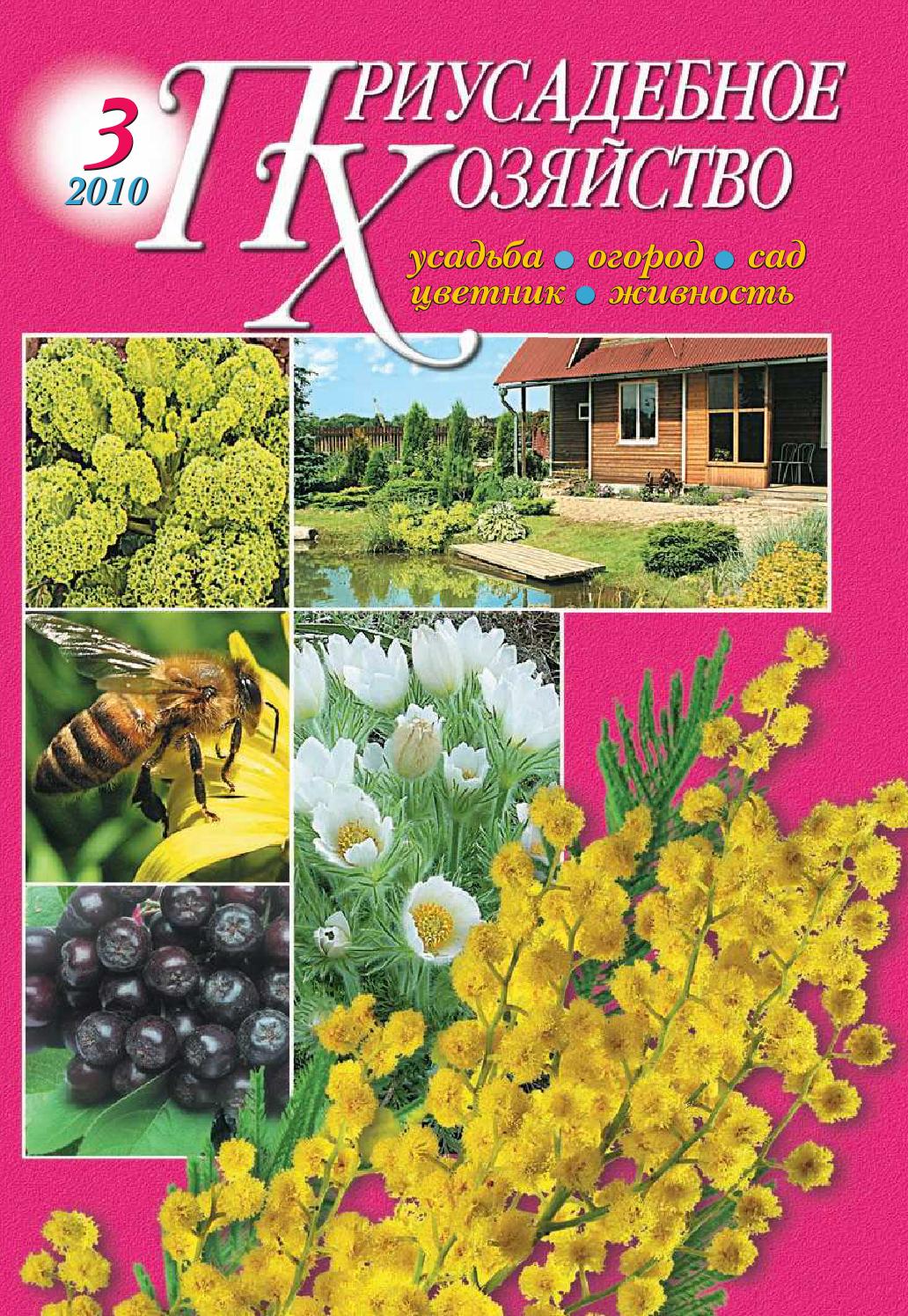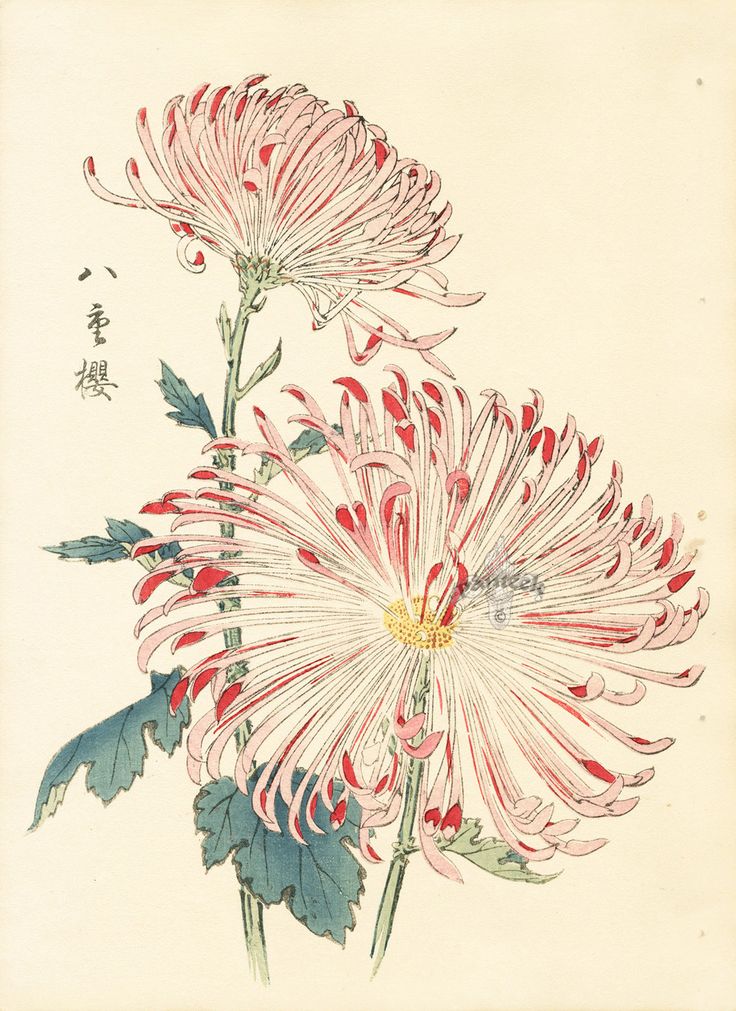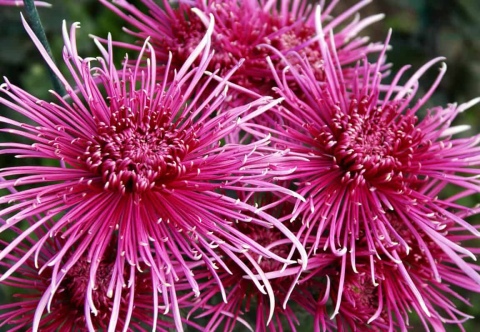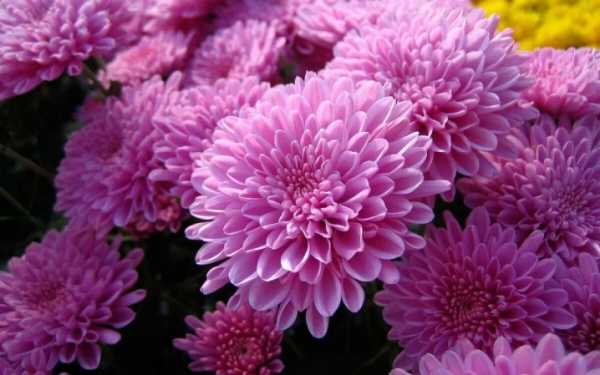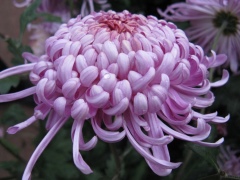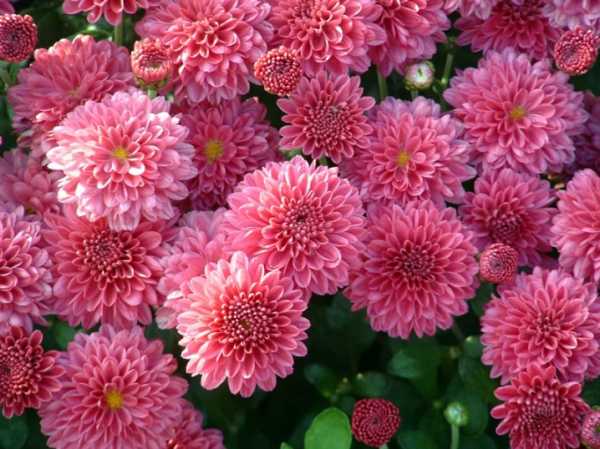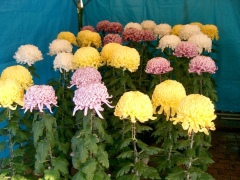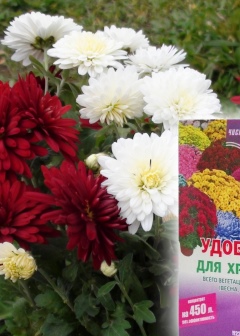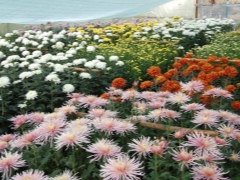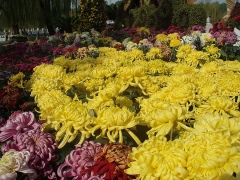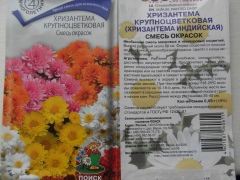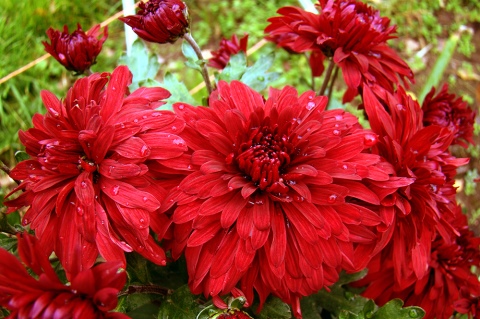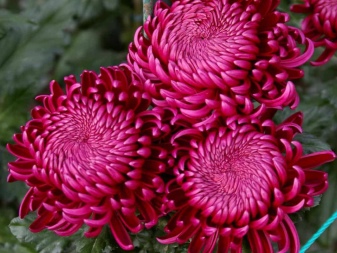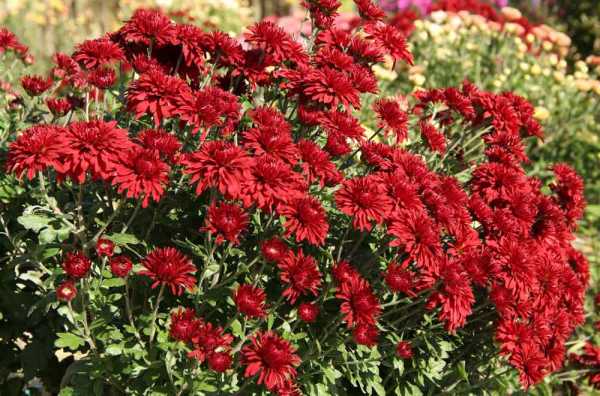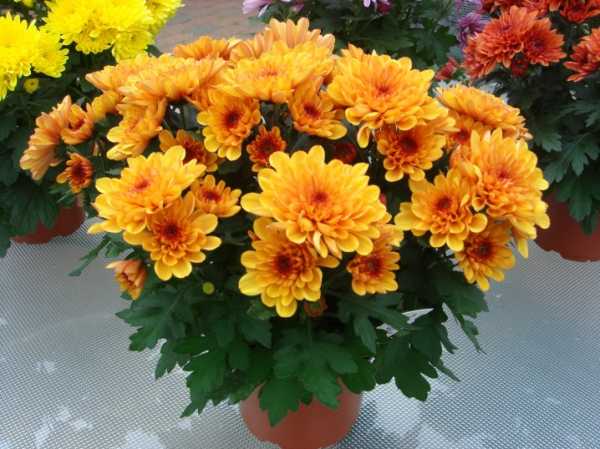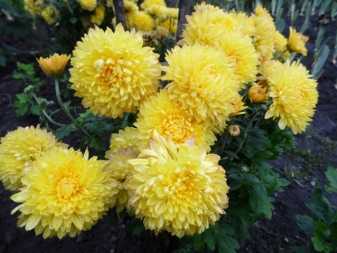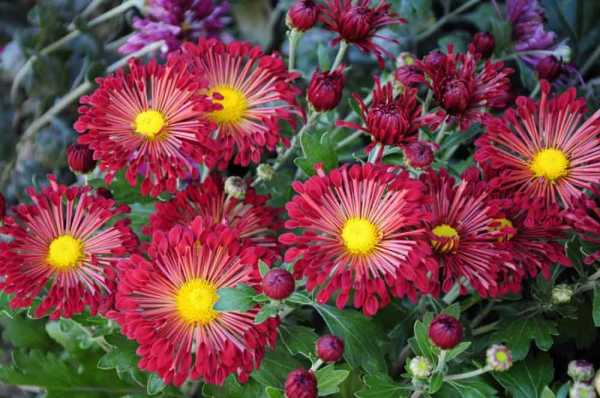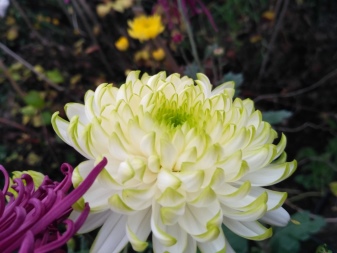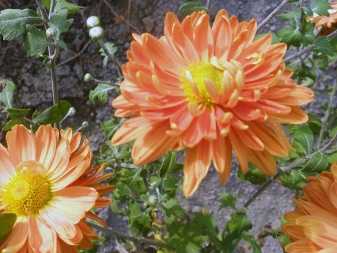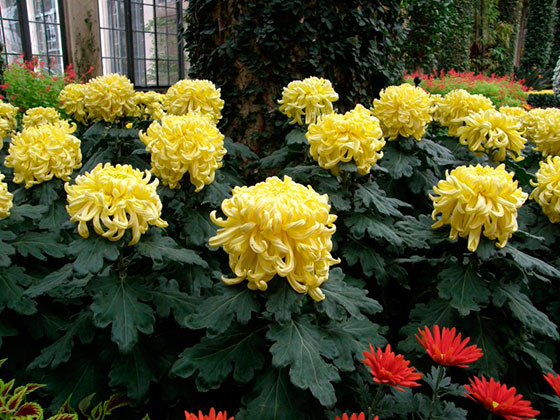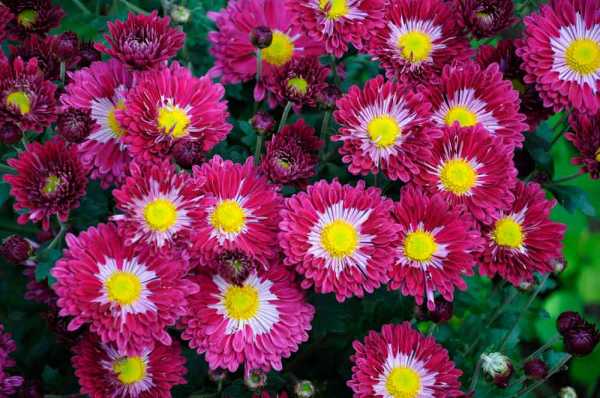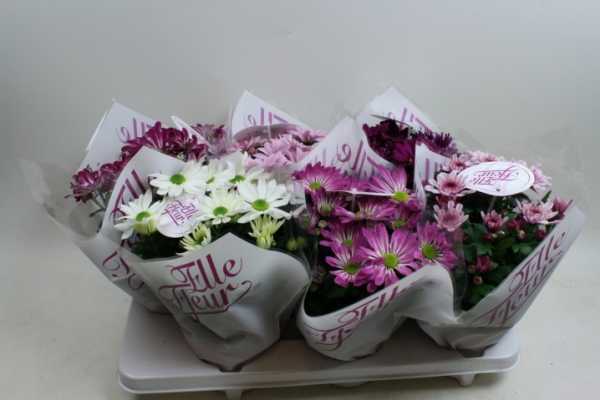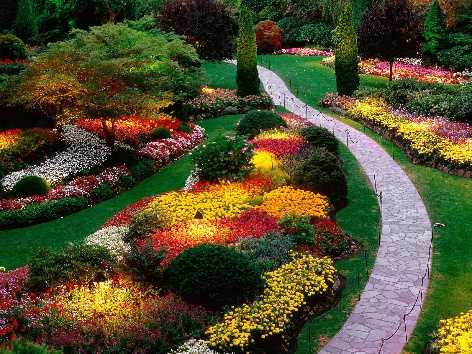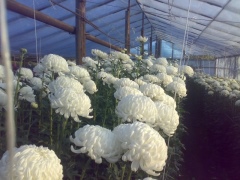Types and varieties of chrysanthemums
With a huge number of chrysanthemum cultivars, unfortunately, there is still no single classification of varieties and hybrids of this plant. Different countries use different systems. Varieties are divided according to the size of the inflorescences and the height of the bush, according to the shape of the inflorescence, according to the timing of flowering. There is also a division into perennial and annual chrysanthemums.
Annual chrysanthemums include the following species:
- chrysanthemum tricolor, or keeled (varieties Nordstern, Kokard and Flammenstahl);
- field chrysanthemum, or sowing (varieties Helios, Stern des Orients);
- chrysanthemum corona (Tetra Komet variety).
Also known in culture are annual multi-stemmed chrysanthemums, or Minok, daisy, maiden, marsh, and also prominent, or turned.
The rest of the species, garden forms, varieties and hybrids can be grown in perennial culture.
By the timing of flowering, chrysanthemum cultivars are divided into:
- early (Deliana, Zembla Yellow, Handsam);
- medium flowering (Froggy, Anastacia lil, Orange);
- late (Rivardi, Larissa, Avignon).
Simple chrysanthemums differ in the shape of the inflorescences:
- non-double (Pat Jois, Ben Dixon);
- semi-double (Baltika, Amazonka, Natasha);
- anemone (Andre Rose, Vivienne, Lady Beauty)
and terry:
- chrysanthemum spherical (Kremist, Broadway, Arctic);
- chrysanthemum hemispherical (Trezor, Gazella, Zlata Praga);
- chrysanthemum unfolded (Tracy Waller, Regalia);
- chrysanthemum flat (Valley Roof, Swan Song);
- chrysanthemum pomponnaya (Fairy, Bob, Denis);
- chrysanthemum radial (Tokyo, Pietro, Magdalena);
- spider chrysanthemum (Grace, Spring dawn on the Su-Ti dam).
Depending on the size of the flower, chrysanthemums are large-flowered, medium-flowered and small-flowered.
Large-flowered chrysanthemum reaches a height of 120 cm, and the diameter of its inflorescences, which have different shapes, can be from 10 to 25 cm. These varieties are grown mainly for cutting. Large-flowered chrysanthemums do not differ in a high level of winter hardiness, but recently cultivars have appeared that normally winter in the open field. Varieties:
- Anastacia Green - green chrysanthemums on a bush 80 to 120 cm high;
- Zembla Laylek - a variety with large double inflorescences with wide ligulate flowers on a bush up to 90 cm high;
- Tom Pearce is a bush up to one and a half meters high with red globular inflorescences 22 cm in diameter. The reverse side of the reed flowers is orange.
The mid-flowered chrysanthemum, which is usually called decorative, reaches a height of no more than a meter. Its inflorescences are 10-18 cm in diameter. It is used not only for cutting, but also for decorating borders, balconies and terraces. Varieties:
- Pink chamomile is a chrysanthemum with a height of 60 to 90 cm with dark pink inflorescences with a diameter of 6-8 cm;
- Splashes of champagne - a bush up to 90 cm high with needle-like pale pink baskets and yellow dusting in the center. There is a variety with golden inflorescences;
- Golden Fleece - yellow chrysanthemums with an orange tint on a bush up to 60 cm high.
Small-flowered chrysanthemum, or Korean chrysanthemum, is a species representing frost-resistant plants, which are simply called "oaks" for the shape of the leaves, reminiscent of oak. In height, the bushes of these chrysanthemums reach from 25 to 120 cm. Numerous inflorescences with a diameter of 2 to 10 cm are formed on them, simple and double, painted in all kinds of colors. Varieties:
- Snow White - double white chrysanthemums with a diameter of 6-7 cm on a compact bush up to 70 cm high;
- Amber - on small bushes with a height and a diameter of about 50 cm, terry bright yellow baskets with a diameter of up to 7.5 cm are formed;
- chrysanthemum Multiflora is a series of early varieties of a new selection with spherical inflorescences of a wide range of colors.
Planting low-growing chrysanthemums
Growing this garden plant is a fairly simple task that does not require a lot of time, money and physical effort. It is unpretentious and needs attention only when planting and actively flowering.
The first thing to consider is the love of chrysanthemums for sunlight. They need to be planted in well-lit areas, otherwise you can get elongated shoots. The hot midday sun can harm the flowers, so the ideal planting option is a place where the sun's rays do not fall at midday. If there is no opportunity to plant the bushes, then at noon they can be sheltered from the sun with a light, light cloth.
The soil requirements are also fairly simple. Any type of soil is suitable, as long as it is well-drained and free of too much sand, as well as fertilized with peat, manure or compost. It is also not worth overfeeding the planting site with fertilizers, since in this case you can get more leaves than flowers. Fertilizing is optional if the soil is already saturated with organic matter.
The best time for planting is the end of May. You can plant until the end of June. Otherwise, the plant may not develop enough for the onset of cold weather to calmly endure the winter outdoors. The optimal time of day for this activity is early morning or evening, and preferably a cloudy day.
The very procedure for planting a low-growing chrysanthemum is somewhat different from planting tall ones. Dig holes up to 40 cm deep, between which there should be a distance of at least 25 cm. A certain amount of drainage material (sand, etc.) is placed in a well-watered hole. After distributing the plant in a hole with a slight depression of the roots, a root-stimulating substance such as Kornevin can be poured onto the bottom.
In the case of propagation of a bush by cuttings, a shoot about 15 cm long is taken from a developed bush.It is worth considering a few points. Cuttings with small inflorescences take root most quickly. Also, the planting of the so-called late cuttings, that is, those that grew in mid-to-late spring, will also benefit the speed of rooting. Rooting occurs worst of all in cuttings with thick shoots. Planting cuttings should be carried out so that they have time to develop before the cold weather. The deadline for planting is until the end of spring.
The planted plant needs pinching to prevent shoot growth and better nourishment of the inflorescences. After a couple of weeks, a couple of nodes can be removed to prevent uncontrolled and improper shoot growth. In the case of planting ball-shaped varieties, this action should provide the plant with the correct ball shape. To achieve the appearance of larger buds, you need to cut the bush so that a small number of inflorescences remain.
At first, the plant will be fragile, and May frosts or hot sun can harm it. To avoid negative consequences, you can cover the seedling, preferably with a light non-woven material that will not damage the leaves.
In the case of planting seeds, the best time to do this is early March. For the appearance of seedlings, drainage (river sand) is poured into a tub or other container, a mixture of garden soil, peat and humus is poured. On top of all this, seeds are placed, which must be slightly immersed in the ground, without burying in depth. The tub, where the landing was made, is covered with a plastic bag and placed in a lighted place in a room with a room temperature around +25 ° C.
Chrysanthemums bush white: varieties
The total number of varieties of white chrysanthemums is hardly quantifiable. We list just a few of them.
Chamomile:
- Snow Maiden (Snegurochka). Non-double, bush. Height - 25 cm, flowers are simple 4 cm in a circle. White with a large yellow center, short, wide petals. Blooms from August to October.
- Chick (Chic, Chic). Shrub, non-double, similar to the Baccardi variety, but with wider petals. Grown for cutting. White reed petals surround the green disc. In the circumference of the inflorescence is 7 cm, the length of the stem is about 55 cm. Flowering from August to October.
- Himalaya.A non-double variety with short, wide, reed leaves and a greenish disc. The height of the bush is up to 60 cm, the inflorescence circumference is up to 6 cm. It blooms in September.
Korean tall large-flowered:
- White bear. Terry single-headed variety, pompom, stem height up to 90 cm, basket circumference up to 16 cm. Petals at the beginning of flowering are yellowish in the center, then become snow-white. Bloom from August to November.
- White swan. Terry single-headed, height up to 85 cm, inflorescence circumference up to 8.5 cm. It blooms in September.
- White poodle. Unusual double-headed, single-headed variety. Curly-bent thin ligulate petals of creamy white color, inflorescence up to 18 cm in circumference. Stem length up to 80 cm. Flowering occurs in the first half of November.
- Ribonet. Terry single-headed variety, lush large white inflorescences in a circumference of up to 20 cm. Stem length up to 80 cm. Blooms from October to November.
- Pearl. Terry lush inflorescence with small white baskets in circumference up to 5 cm, stem length up to 60 cm. Closed bush. Very early variety, flowers in July.
- Evelina (Evelyn Bush, Evelina). Terry variety, inflorescence up to 9 cm in circumference. Wide ligulate petals taper towards the edge. It reaches a height of 60 cm. It blooms from September to early November.
- Helen (Helen White, Ellen White). Terry grade. In the center, the petals are pale yellow. In a circle of inflorescences up to 8 cm. The length of the stem is 50-60 cm.
- Regina White. Terry, large flowers up to 10 cm, powerful stems, up to 70 cm long, blooms in September-October.
Korean multiflora:
- White dance. The circumference of the flowers is up to 8 cm, the length of the stems is about 60-70 cm. In the process of flowering, the edges of the petals turn slightly pink. Super early variety, blooms in July.
- Belyanochka (Belyanochka). Terry variety, reed petals form a lush inflorescence. The circumference of the flowers is up to 7 cm, the length of the stems is up to 70 cm. It blooms from August to October.
- Furor (Furor) bush. Terry variety, lush inflorescence in the center has a light green-cream color. Inflorescences in circumference up to 8 cm, stem length up to 70 cm. It blooms from August to September.
Korean mid-sized:
- Euro (Euro) bush. Terry variety, reed leaves in the center are smaller than those located at the edges. The middle is greenish-yellow. The length of the stems is up to 70 cm, the circumference of the inflorescence is up to 7.5 cm. It blooms from late August to late September.
- Coconut. Terry bush variety. Snow-white tubular petals are collected in a neat lush spherical inflorescence. The length of the stems is up to 70 cm, the circumference of the inflorescence is up to 12 cm.
- Sky (Sky) bush. Terry variety with a hemispherical inflorescence of reed petals. The middle of the inflorescence is lemon-yellow, the flower diameter is up to 7 cm. Height is up to 60 cm. Flowering from August to October.
- Crystal chrysanthemum (Hrustalnaja chrysanthemum). Semi-double, single-headed cultivar with long, thin ligulate petals and a lemon-yellow center. Flowering - August-October.
Korean stunted (curb):
- Bride's Outfit (Bride, Bridesmaid Dress, Nevesta). Terry grade. Inflorescence in the form of a basket up to 7 cm in circumference. Height up to 20 cm. It blooms in August.
- Bonita (Bonita) bush. Semi-double grade, looks like Euro grade. Reed petals are snow-white in color. The height of the bush is up to 50 cm, the inflorescence circumference is small, up to 6 cm. It blooms in September.
As folk wisdom says, you can endlessly look at three things: fire, water and ... white chrysanthemums. These colors are surprisingly combined solemnity and simplicity, modesty and pride, beauty and laconicism. Nature created these recognized queens of the autumn garden, as if specially so that we could more easily endure the autumn blues and even remember in the frost that spring is just around the corner.
How to take care of it properly?
The chrysanthemum bush is unfair to be classified as a demanding plant, and yet, like any other domestic culture, it requires some care if you want to get the maximum result. For most perennial varieties, sharpened for our country with its harsh climate, all care consists in regular and timely watering, feeding and pruning.
Chrysanthemum, on the one hand, loves sunlight, on the other, it prefers a short daylight
Directional lighting is more of a hindrance to lush bloom, so it is important to diffuse it in the fall. When growing a plant indoors, focus on the eastern and western windowsills
It is recommended to maintain air humidity at the level of 40-50%.
Chrysanthemum is considered a plant that is resistant to an arid climate, but we must not forget that it is also hygrophilous. In the heat, it is advised to regularly spray the trunk and branches of the plant. Watering is done as the soil dries up - in fact, the topsoil should never dry out completely. Water for irrigation should first be defended to settle various impurities, before using it, it should first be warmed up in the sun.
If you originally planted chrysanthemum in soil fertilized with humus and minerals, this is already a guarantee of a lush flowering of the plant, but it will still not be superfluous to use additional fertilizers. For the first time, fertilizers are applied already at the time of planting in open ground - the most successful option will be a combination of organic fertilizers with an admixture of superphosphate, thanks to which the plant will quickly settle in a new place and develop the root system. After 2 weeks, the procedure can be repeated. The chrysanthemum is fed for the third time already at the stage of bud formation, and now it is advised to add potassium and phosphorus in a 2: 1 ratio.
Pinching and pruning are beneficial for the ornamental characteristics of the plant and its overall development - these procedures promote the growth of both the branches above the ground and the root system below the ground. If your plant belongs to small-flowered varieties, experts advise pinching it over the fifth leaf, which will help to achieve the formation of a dense crown. If the gardener sets himself the goal of growing large and bright flowers, it is advisable to remove all lateral shoots, directing all the forces and juices of the plant to the development of buds.
Despite its frost resistance, chrysanthemum still needs some preparation for the cold season, and appropriate procedures should be started in most of Russia from the end of August. The gardener's task is to provide the pet with a decent supply of nutrients for wintering, which the chrysanthemum can get from phosphorus-potassium dressings
In addition, after flowering is complete, it is important to cut the plant to a height of only 10-15 cm and spud the remaining stem by mulching the soil above the root system with straw, foliage or dense spruce branches.
Unfortunately, not all varieties of chrysanthemums are frost-resistant, and in order to withstand our winter, hybrids of European origin and most of the beautiful large-flowered varieties must be moved indoors for the winter. To do this, before the first frosts, they are carefully dug up and, together with the adhering earthy lump, are sent to boxes made of wood. It is curious that such bushes hibernate anyway at low temperatures - only 2-6 degrees above zero, but they need an abundance of light and regular moistening of the roots. If you have a cellar or basement, then if there is normal lighting there, it will be the best place for chrysanthemum wintering.
Even if your flower is originally indoor and does not grow outdoors in the warm season, you still need to prepare it for winter. The procedure is similar to that in other situations - dried buds and old twigs with leaves are cut off, the plant is greatly reduced in size, and the pot with it is moved to cooler conditions than before. The main thing is to protect the wintering chrysanthemum from drafts and excessive humidity, as well as to provide it with a temperature of about 5 degrees above zero, while it does not need fertilizers during "hibernation", and it needs to be watered much less often.
Classification according to various criteria
In light of the large number of varieties of chrysanthemums, the available diversity requires a well-ordered classification. That is why the garden and botanical grouping of artificially bred plants, as well as wild species and varieties, provides for the division of chrysanthemums according to a number of characteristics. The grouping of cultures is as follows.
Life cycle
There are two types of plants in this category.
- Perennial chrysanthemums - most of this category is occupied by greenhouse and Korean flowers. They are distinguished by lush and abundant flowering, as well as resistance to all weather conditions. Most of the crops are cut.
- Annual varieties are notable for a high level of adaptation to any conditions, frost resistance, in addition, flowers require fairly simple agricultural technology. As a rule, annual chrysanthemums are able to bloom before the arrival of the first fall frost.
Flowering period of crops
In this category, plants are usually divided into groups, taking into account the months in which they bloom. Today, the following types of chrysanthemums are distinguished
- Flowers that bloom in November. These plants are late varieties.
- Chrysanthemums blooming in October are medium.
- Early species and varieties usually bloom in September.
Frost resistance
Since these crops are grown in different regions, where winters differ significantly in their temperature indicators, chrysanthemums are divided into two groups.
- Plants with a high degree of frost resistance. As a rule, such flowers can withstand even the first snow with a decrease in the marks on the thermometer. Among the winter-hardy varieties, the most viable crops are considered to be undersized terry chrysanthemums.
- The second group contains plants that are recommended to be cultivated only in southern and mild climates. This is due to the late flowering of chrysanthemums, which begins in late autumn.
Inflorescence sizes
Taking into account the diameter of the flowers, chrysanthemums can be as follows
- Medium-flowered - they can be grown not only in the open field, but also on the balcony, veranda, windowsill. As a rule, the size of the inflorescences of such chrysanthemums will be 10 centimeters.
- Large-flowered - varieties and species of this category have a diameter of inflorescences within 25 centimeters. It is these varieties that are mostly grown for the subsequent creation of bouquets and other floral arrangements.
- Small-flowered chrysanthemums will be small in size, as well as the smallest flower diameter, which usually does not reach 10 centimeters.
Inflorescence shape
In light of the presence of a large number of different chrysanthemums, it is also customary to divide them, taking into account the appearance of the flower itself. Today, among wild and hybrid crops, the following are distinguished
- Simple - such a flower has many similarities in appearance with an ordinary chamomile. Chrysanthemums usually have a completely open core, and straight petals are arranged around in several rows. The colors of simple crops may vary.
- Terry varieties stand out in large numbers with closed petals, which will grow in one row in a circle.
Garden chrysanthemum care
Even an amateur gardener can grow a chrysanthemum in his garden, but in order for the bushes to be as lush, beautiful and not sick, you need to know a few tricks. For example, after the seedlings planted in open soil take root well, get stronger and form an eighth true leaf plate, they pinch it to make the bushes more lush. Soon, side shoots should appear on the plant, when this happens, pinch them too, as a result, your site will be decorated with spectacular dense bushes, and when flowers appear on them, they will look like fluffy balls.
When growing large-flowered varieties, you should pay attention to the fact that it is recommended to remove all side shoots from them, while leaving only a few of the most powerful ones. Cut shoots can be used as cuttings, they root very quickly
Parts of vigorous varieties need support; for this, a mesh, metal pegs or a wire structure can be installed near the bush. It will support the bush and prevent it from decaying.
Watering
It is necessary to water the culture regularly and abundantly, if the plants do not have enough moisture, then their shoots will become lignified, and the inflorescences will not be so beautiful. It is necessary to water the bushes with rain or well-settled water (it can be mixed with 2 drops of ammonia). Water is poured at the root, try not to get it on the surface of the leaf plates. After watering, the surface of the earth around the bushes is loosened, and all weeds are removed. In order to facilitate the care of the plant, immediately after planting the seedlings, the surface of the site is covered with a layer of mulch.
Fertilizer
In order for the bushes to grow and develop normally, they are systematically fed. During the growing season, the flowers are fed at least 3 times, for this they alternately use organic matter and mineral fertilizers. At the beginning of the growing season, the bushes need nitrogen, ammonia nitrogen is best suited for this, thanks to such feeding, the bushes will quickly grow green mass. To stimulate lush flowering, chrysanthemums are fed during the formation of buds with potassium-phosphorus fertilizer.
For feeding, liquid nutrient solutions are used, they are poured under the root of the bushes the next day after watering or rain. The first time the plants are fed in the first 1.5–2 months after they are planted in the open ground. From organic matter, you can use burned-out mullein or bird droppings. Experienced gardeners argue that it is better not to feed the chrysanthemum than to burn it.
Chrysanthemum multiflora, feeding during flowering.
Transfer
In one and the same place, the flower can be grown no longer than 3 years, otherwise it will start to "be capricious", namely: the inflorescences will begin to grind, and it will also get sick much more often. In this regard, in the spring, it is necessary to remove an adult bush (over three years old) from the ground and transplant it.
As a rule, this procedure is carried out in conjunction with the division of the bush, so that the plant can be propagated. To do this, carefully remove it from the soil, while trying not to injure the root system, and shake off the soil from it. Divide the bush into several divisions, each of which should have shoots and roots, for this you can use a pruner or a very sharp knife. After that, the delenki are planted in a well-lit area in the same way as seedlings (see above).
Varieties and varieties
As a result of the work of breeders from different countries, there is now a huge number of perennial winter-hardy varieties of this decorative culture.
From undersized varieties will attract attention:
- "Super Bronze" with fiery bronze double inflorescences;
- "Minx" - a lush curb bush with raspberry inflorescences and peak flowering in September;
- Krasunya is a beige-red original September variety that tolerates drought well.
There are border varieties 20 cm high and for the second level in a 40 cm flower garden.
Among medium-sized varieties, suitable for both elegant bouquets and for planting in open soil, the following are in demand:
- "Surprise" - an autumn-flowering variety with terry terracotta inflorescences;
- "Lelia" is a late-flowering columnar-shaped variety with abundant flat small inflorescences of a violet-pink hue. Blooms until frost.
Among tall frost-resistant perennials wintering in open soil, the following stand out noticeably.
- "Umka" - with white with a pinkish tinge pompom-shaped terry inflorescences.The middle of the flowers is creamy. Used for cutting and landscaping. It blooms twice per season.
- "Apple Blossom". Large-flowered type of white, pink, burgundy and cream flowers with a subtle scent. It is used for cutting. Blooms until October.
- "Sonatina" is a variety with bright pink double inflorescences with a slight silvery sheen and smooth emerald green foliage. Blooms in late autumn.
- "Cream Jewel". In early July, the color is almost white with the most delicate creamy pink shades, and in August - apricot tone.
- "Smile of Autumn" is a late-flowering plant with inflorescences ranging from light to dark orange.
- "Emmy" is a variety with bright and large inflorescences of cream and brown color, blooms in early autumn.
- Enona is a cream-colored and yellow-flowered variety with long flowering in summer and autumn.
7photos
Solid plantings that create the effect of a flower carpet, grown from a mixture of seeds, look especially impressive. For example, a mixture of "Stars of the Galaxy" is in demand - medium-sized cold-resistant perennials with a variety of bright double inflorescences, baskets of medium and large sizes. The mixture is suitable for planting in containers or outdoor pots. You can transplant crops in a flowering state. The mixture has several shades. The most common tones are yellow, bright red and pale pink.
These varieties have proven themselves excellently in Russian regions.

